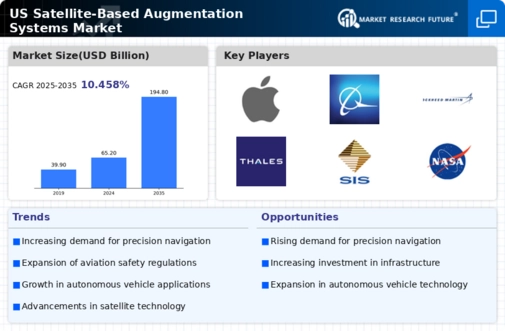Enhanced Military Applications
The satellite based-augmentation-systems market is witnessing increased demand from military applications. The US Department of Defense is investing heavily in advanced satellite technologies to enhance navigation and targeting capabilities. With an estimated budget of $700 million allocated for satellite augmentation systems, the military seeks to improve operational effectiveness in various missions. This focus on military applications is likely to propel the satellite based-augmentation-systems market, as defense contractors and agencies require cutting-edge solutions to maintain strategic advantages in complex environments.
Rising Adoption of Autonomous Systems
The growing trend towards automation in various industries is significantly impacting the satellite based-augmentation-systems market. As sectors such as transportation, agriculture, and logistics increasingly rely on autonomous systems, the demand for precise positioning and navigation data is escalating. For instance, the autonomous vehicle market is projected to reach $557 billion by 2026, necessitating robust satellite-based augmentation systems for safe operation. This rising adoption of autonomous technologies is likely to drive the satellite based-augmentation-systems market, as companies seek reliable solutions to ensure accuracy and safety in their operations.
Increased Investment in Infrastructure
The satellite based-augmentation-systems market is experiencing a surge in investment aimed at enhancing infrastructure. This trend is driven by the need for improved navigation and positioning services across various sectors, including transportation and agriculture. The US government has allocated substantial funding, estimated at $1.5 billion, to upgrade satellite systems and ground stations. This investment is expected to bolster the accuracy and reliability of satellite-based services, thereby attracting more users. As infrastructure improves, the satellite based-augmentation-systems market is likely to expand, with more industries adopting these technologies to enhance operational efficiency and safety.
Growing Need for Disaster Management Solutions
The satellite based-augmentation-systems market has become increasingly recognized for its potential in disaster management and emergency response. As natural disasters become more frequent, the demand for accurate and timely data is critical. Satellite systems can provide real-time information on weather patterns, terrain changes, and infrastructure damage. The US government has initiated programs to integrate satellite-based solutions into disaster response strategies, with funding exceeding $300 million. This growing need for effective disaster management solutions is likely to drive the satellite based-augmentation-systems market, as agencies seek reliable data to enhance preparedness and response efforts.
Expansion of Internet of Things (IoT) Applications
The proliferation of Internet of Things (IoT) devices is significantly influencing the satellite based-augmentation-systems market. As more devices become interconnected, the need for accurate positioning and navigation data is paramount. The US IoT market is projected to reach $1 trillion by 2026, creating a substantial demand for satellite-based solutions that can support various applications, from smart cities to precision agriculture. This expansion of IoT applications is likely to drive the satellite based-augmentation-systems market, as businesses and governments seek to leverage satellite data for enhanced operational efficiency and decision-making.

















Leave a Comment